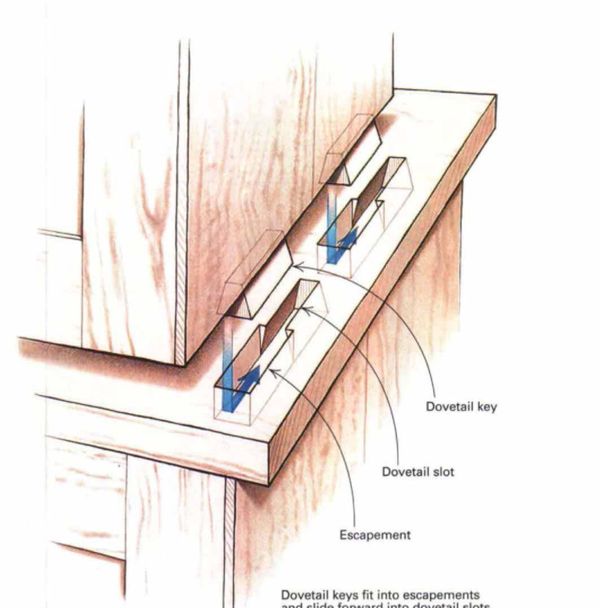Housed Sliding Dovetails
A strong, hidden joint that's ideal for large cabinets
Synopsis: Tony Konovaloff makes furniture with a lot of knockdown joints to keep big pieces manageable in his small shop. He devised a strong connection method using housed sliding dovetails, which holds cases tightly together but knocks down without binding. They don’t require special tools to make, or very much time, he says. He explains how to cut the dovetails first and then lay out the slots and escapements. He cuts the escapements before the dovetail slots and then fits the slots to the dovetails. Paste wax on all parts helps the joint work smoothly.
My shop is quite small. There is just enough room for a bench, a tool box and a place to stand and work. I like it that way. My tools are always within easy reach and are hard to misplace. And the shop doesn’t require much heat in the winter. But there’s one problem: Large cabinets don’t leave much room to work. Even desks take up all the available floor space. And to work on large china cabinets, I have to take down the ceiling lights.
Having a small shop doesn’t keep me from making large cabinets. However, I do make a lot of knockdown joints to keep big pieces of furniture manageable.
There are endless ways to connect large case pieces, but most knockdown designs I’ve seen are lacking in one way or another. Some are weak; others require clunky or expensive hardware. Sliding dovetails are an option, but they show at the back of the case, and they tend to bind.
To solve some of these problems, Idevised a strong connection using housed sliding dovetails (see the drawing above). I cut small dovetail keys on the bottom of the sides of the upper case and dovetail slots with escapements on the top of the lower case. The keys fit down into the escapements and then slide forward into the slots, locking the cases together and eliminating the need for hardware. And nothing shows in the front or back when the cases are assembled.
The joint holds upper and lower cases tightly together but knocks down smoothly and easily without binding. It doesn’t require special tools to make or very much time. But to make sure that you understand what’s going on with the joinery, it’s a good idea to work up a practice piece.
Cut the dovetails first
Before gluing up the top half of the case, I cut the dovetails on the bottoms of the case sides. There are many ways to do this. I use a dovetail plane, but a router and jig would work as well.
From Fine Woodworking #123
For the full article, download the PDF below:
Fine Woodworking Recommended Products

Leigh Super 18 Jig

Freud Super Dado Saw Blade Set 8" x 5/8" Bore

Suizan Japanese Pull Saw






















Log in or create an account to post a comment.
Sign up Log in